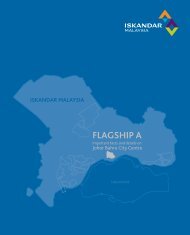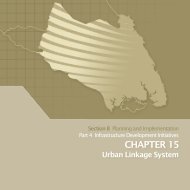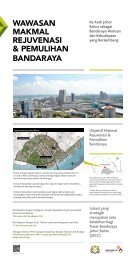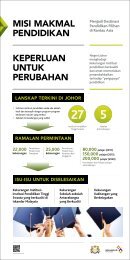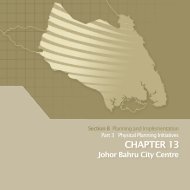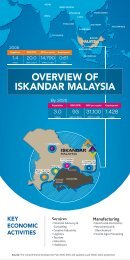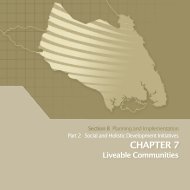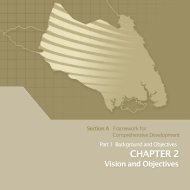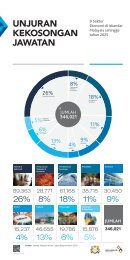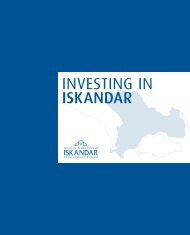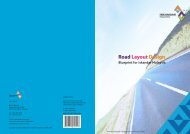Drainage and Stormwater Management - Iskandar Malaysia
Drainage and Stormwater Management - Iskandar Malaysia
Drainage and Stormwater Management - Iskandar Malaysia
Create successful ePaper yourself
Turn your PDF publications into a flip-book with our unique Google optimized e-Paper software.
TM<br />
<strong>Drainage</strong> <strong>and</strong><br />
<strong>Stormwater</strong> <strong>Management</strong><br />
Blueprint for Isk<strong>and</strong>ar <strong>Malaysia</strong><br />
ISBN 978-967-5626-26-5
<strong>Drainage</strong> <strong>and</strong> <strong>Stormwater</strong><br />
<strong>Management</strong> Blueprint for<br />
Isk<strong>and</strong>ar <strong>Malaysia</strong>
ACKNOWLEDGEMENT<br />
List of agencies/ departments involved in developing DSWM blueprint<br />
Federal<br />
Department of <strong>Drainage</strong> <strong>and</strong> Irrigation (JPS)<br />
Ministry of Housing <strong>and</strong> Local Government (KPKT)<br />
Department of Works (JKR)<br />
Department of Town <strong>and</strong> Country Planning (JPBD)<br />
Department of Environmental (JAS)<br />
Suruhanjaya Perkhidmatan Air Negara (SPAN)<br />
Department of National L<strong>and</strong>scape (JLN)<br />
State<br />
Chief Minister Office (Pejabat Menteri Besar)<br />
State Economic Planning Unit (UPEN Johor)<br />
Johor Bahru L<strong>and</strong> Office<br />
Kulaijaya L<strong>and</strong> Office<br />
Pontian L<strong>and</strong> Office<br />
Badan Kawal Selia Air Johor (BAKAJ)<br />
Johor Bahru City Council (MBJB)<br />
Central JB Municipal Council (MPJBT)<br />
Kulai Municipal Council (MPKu)<br />
Pasir Gudang Municipal Council (MPPG)<br />
Pontian District Council (MDP)<br />
Jabatan L<strong>and</strong>skap Negeri<br />
Local community<br />
Others<br />
Syarikat Air Johor<br />
Indah Water Consortium
Foreword<br />
Isk<strong>and</strong>ar <strong>Malaysia</strong> is a National Project to develop a vibrant new region at the southern gateway of<br />
Peninsular <strong>Malaysia</strong>. A regional authority body Isk<strong>and</strong>ar Regional Development Authority (IRDA) was<br />
formed with specific roles to plan, promote <strong>and</strong> facilitate in which to coordinate the economic,<br />
environmental <strong>and</strong> social planning, development <strong>and</strong> management of Isk<strong>and</strong>ar <strong>Malaysia</strong>. IRDA refers to<br />
The Comprehensive Development Plan (CDP) as the guiding document in developing Isk<strong>and</strong>ar<br />
<strong>Malaysia</strong>, <strong>and</strong> subsequent to that, blueprints are prepared as a subset <strong>and</strong> supplementary document to<br />
CDP, which outlines detail findings, strategies, implementation <strong>and</strong> action plans.<br />
The <strong>Drainage</strong> <strong>and</strong> <strong>Stormwater</strong> <strong>Management</strong> (DSWM) blueprint for Isk<strong>and</strong>ar <strong>Malaysia</strong> has been<br />
prepared to assist the public <strong>and</strong> private sector <strong>and</strong> the community to work together in managing<br />
drainage <strong>and</strong> storm water concerns within the Isk<strong>and</strong>ar <strong>Malaysia</strong> region so that all can benefit in<br />
making the region a place to invest, work, live <strong>and</strong> play.<br />
Floods <strong>and</strong> flash floods can cause a significant impact to the performance <strong>and</strong> economy of Isk<strong>and</strong>ar<br />
<strong>Malaysia</strong>. With this Blueprint, Isk<strong>and</strong>ar <strong>Malaysia</strong> shall have a reliable, efficient <strong>and</strong> sustainable drainage<br />
system <strong>and</strong> stormwater management that can prevent floods or associated problems which may<br />
hinder the development. The objectives of the Blueprint, are as follow: to support <strong>and</strong> improve the<br />
implementation of Government’s policy on <strong>Drainage</strong> <strong>and</strong> <strong>Stormwater</strong> <strong>Management</strong> i.e. MSMA<br />
Guidelines; to improve performance of drainage <strong>and</strong> storm water infrastructure with the aim of<br />
creating a system that is of international st<strong>and</strong>ards; <strong>and</strong> to develop a practical <strong>and</strong> effective master plan<br />
to mitigate prevailing flood in Isk<strong>and</strong>ar <strong>Malaysia</strong>.<br />
This blueprint has incorporated a set of Forty-four initiatives for <strong>Drainage</strong> <strong>and</strong> <strong>Stormwater</strong><br />
management that is critically address <strong>and</strong> tackle the region’s drainage, <strong>and</strong> flooding issues as Isk<strong>and</strong>ar<br />
<strong>Malaysia</strong> develops.<br />
To facilitate the implementation, the blueprint outlines a set of new coordinating structure to manage<br />
new partnerships expected to come from public agencies <strong>and</strong> private organisations working together<br />
on practical implementation to improve drainage system, on how to collect storm water for daily<br />
usage, <strong>and</strong> to prevent the flooding in Isk<strong>and</strong>ar <strong>Malaysia</strong>. Consequently, we look forward to a metropolis<br />
that is safe <strong>and</strong> secure from flooding toward becoming a place to invest, live, work <strong>and</strong> play within a<br />
Metropolis environment of an International St<strong>and</strong>ard.
CONTENT<br />
1 INTRODUCTION<br />
1.1 Background of Project 1<br />
1.2 Objectives of the Blueprint 1<br />
1.3 Scope of Work 1<br />
2 DATA COLLECTION<br />
2.1 Collection of Data 2<br />
2.2 Topographical Data <strong>and</strong> Engineering Survey 2<br />
2.3 L<strong>and</strong>use Information 2<br />
2.4 Hydrological Data 3<br />
3 IDENTIFICATION OF KEY ISSUES<br />
3.1 <strong>Drainage</strong> <strong>and</strong> <strong>Stormwater</strong> <strong>Management</strong> 4<br />
3.2 Legislation, Policies <strong>and</strong> Guidelines 4<br />
3.3 Focus Group Discussion 4<br />
4 ANALYSIS AND FINDINGS<br />
4.1 Review of Existing Legislation, Policies <strong>and</strong> Guidelines 5<br />
4.2 Review of Key Institutions Related to DSWM 5<br />
4.3 Review of Key Legislations Related to DSWM 8<br />
4.4 Review of L<strong>and</strong>use Planning Guidelines 10<br />
4.5 Review of <strong>Drainage</strong> Pattern And Distribution 10<br />
4.6 Gap Analysis 11<br />
4.7 Implementation Framework <strong>and</strong> Institutional Arrangement 11<br />
5 HYDROLOGICAL AND HYDRAULIC ANALYSIS<br />
5.1 Hydrological Study 13<br />
5.2 Hydraulic Analysis 14<br />
5.3 <strong>Drainage</strong> System 15<br />
6 BENCHMARKING & EVALUATION<br />
6.1 Introduction 16<br />
6.2 Benefits of Benchmarking 16<br />
6.3 Benchmarking <strong>and</strong> Performance Assessment 16<br />
6.4 Objectives of Benchmarking 16<br />
6.5 Examples of Benchmarking in Other Countries 17<br />
6.6 Benchmarking for Rivers in Isk<strong>and</strong>ar <strong>Malaysia</strong> 17<br />
6.7 Non-Structural Best <strong>Management</strong> Practices 17<br />
7 GEOGRAPHICAL INFORMATION SYSTEM<br />
7.1 Introduction 19<br />
7.2 Objective 19<br />
7.3 Methodology <strong>and</strong> Approach 19<br />
7.4 Metadata And GIS Database Structure 21<br />
7.5 Work Progress 21
8 ENFORCEMENT PLAN AND DSWM INITIATIVES<br />
8.1 Enforcement Plan 21<br />
8.2 <strong>Drainage</strong> <strong>and</strong> <strong>Stormwater</strong> <strong>Management</strong> Initiatives 22<br />
8.3 Conclusion 23<br />
ix
1 INTRODUCTION<br />
1.1 Background of Project<br />
The Isk<strong>and</strong>ar Regional Development Authority (IRDA) is a Federal statutory body established by a<br />
Federal Act of Parliament – IRDA Act 2007 (Act 664). In the IRDA’s Act, IRDA’s role is to regulate <strong>and</strong><br />
co-ordinate various parties in the public <strong>and</strong> private sectors in developing the Isk<strong>and</strong>ar <strong>Malaysia</strong> region<br />
into a strong <strong>and</strong> sustainable metropolis of international st<strong>and</strong>ing by 2025.<br />
Floods <strong>and</strong> flash floods can cause a significant impact to the performance <strong>and</strong> economy of Isk<strong>and</strong>ar<br />
<strong>Malaysia</strong>. With this Blueprint, Isk<strong>and</strong>ar <strong>Malaysia</strong> shall have a reliable, efficient <strong>and</strong> sustainable drainage<br />
system <strong>and</strong> stormwater management that can prevent floods or associated problems which may hinder<br />
the development.<br />
1.2 Objectives<br />
There are several objectives of the Blueprint, as the main objectives are as follows:<br />
a) To support <strong>and</strong> improve the implementation of Government’s policy on <strong>Drainage</strong> <strong>and</strong><br />
<strong>Stormwater</strong> <strong>Management</strong> i.e. MSMA Guidelines.<br />
b) To improve performance of drainage <strong>and</strong> stormwater infrastructure with the aim of<br />
creating a system that is of international st<strong>and</strong>ards.<br />
c) To develop a practical <strong>and</strong> effective master plan to mitigate prevailing flood in Isk<strong>and</strong>ar<br />
<strong>Malaysia</strong>.<br />
1.3 Scope of Work<br />
Some of the work scope to be carried out by the consultant is as follows:<br />
a) Engagement with stakeholders including consumers <strong>and</strong> selected members of the public.<br />
b) Identification <strong>and</strong> establishment of key issues.<br />
c) Analysis <strong>and</strong> finding on studies <strong>and</strong> reports by JPS <strong>and</strong> other agencies.<br />
d) Benchmarking <strong>and</strong> evaluation.<br />
e) Implementation framework, hydraulic engineering analysis <strong>and</strong> institutional arrangement.<br />
f) Enforcement Plan <strong>and</strong> pilot project.
2 DATA COLLECTION<br />
2.1 Collection of Data<br />
Data collection forms an important process in this study. In fulfilling the requirements of the Terms of<br />
Reference (TOR), a review of all relevant information/institutions/laws pertaining to flood, drainage<br />
<strong>and</strong> stormwater management including issues related to water in general <strong>and</strong> l<strong>and</strong> <strong>and</strong> environment<br />
needed to be done.<br />
There are some relevant data <strong>and</strong> information required stated in blueprint. Requests have been made<br />
to the relevant agencies i.e., Jabatan Pengairan dan Saliran (JPS) Johor, the 5 Local Councils <strong>and</strong> IRDA<br />
for the relevant data <strong>and</strong> information. Requests were also made during the Focus Group Discussion <strong>and</strong><br />
the also during the report presentation. In addition, team members have made visits to the study area<br />
<strong>and</strong> have obtained some information from the relevant authorities. Some pertinent publications have<br />
also been obtained.<br />
2.2 Topographical Data <strong>and</strong> Engineering Survey<br />
Topographical <strong>and</strong> engineering survey information’s are required at the areas that are prone to flooding<br />
<strong>and</strong> areas commonly hit by flash floods in Isk<strong>and</strong>ar <strong>Malaysia</strong> to enable these areas to be identified for<br />
remedial works. Survey information of these areas has been requested from JPS Johor <strong>and</strong> the relevant<br />
authorities.<br />
As of this stage, the Consultant has received 17 sheets of 1:25,000 scale topographical maps from the<br />
Jabatan Ukur dan Pemetaan <strong>Malaysia</strong> (JUPEM). However, these 17 sheets only form a partial of the<br />
total 39 sheets required for the river catchments within the Isk<strong>and</strong>ar <strong>Malaysia</strong>.<br />
The engineering survey information/data have been obtained from the JPS Johor, MBJB, MPJBT <strong>and</strong><br />
IRDA.<br />
2.3 L<strong>and</strong>use Information<br />
L<strong>and</strong> use planning for the Isk<strong>and</strong>ar <strong>Malaysia</strong> is guided by the “Integrated L<strong>and</strong> Use Blueprint”, a<br />
document that provides the framework for managing urban growth, change of l<strong>and</strong> use <strong>and</strong><br />
development for the region. To accommodate the needs of a 3-million population by 2025, the<br />
Blueprint has advocated certain planning <strong>and</strong> l<strong>and</strong> use management strategies. The area bounded by<br />
the Urban Growth Boundary is at least 106,900 hectares or 51% of the total l<strong>and</strong> area of the Isk<strong>and</strong>ar<br />
region.<br />
The L<strong>and</strong> Use Blueprint estimates that this l<strong>and</strong> area would be sufficient to accommodate the social,<br />
economic <strong>and</strong> physical infrastructure requirements of a growing population by 2025. These areas<br />
encompass three categories. One of the issues posed at the Focus Group Discussion held on 12th May<br />
2010 is the level of integration <strong>and</strong> coordination (or its inadequacy) in the planning <strong>and</strong> development<br />
of l<strong>and</strong> use strategies amongst the various Local Authorities. By 2025, the L<strong>and</strong> Use Blueprint<br />
recognizes the need to urbanize at least 50% of the Isk<strong>and</strong>ar region to cater to the social, economic <strong>and</strong><br />
infrastructure requirements of the region’s population of 3 million.
2.4 Hydrological Data<br />
The study area covers the whole of Isk<strong>and</strong>ar <strong>Malaysia</strong> development <strong>and</strong> encompasses a l<strong>and</strong> size of<br />
2,217 km2 located at the south of Johor. However, the river catchment boundary exceeds the study area<br />
boundary of Isk<strong>and</strong>ar <strong>Malaysia</strong> (approximately 2.5 times the size) as the main water courses within<br />
Isk<strong>and</strong>ar <strong>Malaysia</strong> is shown in Figure 2.4.<br />
Figure 2.4: Main Water Courses within Isk<strong>and</strong>ar <strong>Malaysia</strong><br />
(Source: Kajian Rancangan Tempatan Daerah Johor Bahru <strong>and</strong> Kajian Tempatan Daerah Pontian)<br />
There are 18 hydrological stations available in the Isk<strong>and</strong>ar <strong>Malaysia</strong>. These are mainly rainfall stations.<br />
Due to the nature <strong>and</strong> short duration of the study, the flood runoff estimations will be based on the<br />
Rational Formula as defined in JPS’s Manual Saliran Mesra Alam (MASMA) for urban areas. For the rural<br />
areas, estimations shall be done using the Hydrological Procedure No. 11 by JPS.
3 IDENTIFICATION OF KEY ISSUES<br />
3.1 <strong>Drainage</strong> <strong>and</strong> <strong>Stormwater</strong> <strong>Management</strong><br />
<strong>Drainage</strong> <strong>and</strong> <strong>Stormwater</strong> <strong>Management</strong> is a very important component to be addressed for Isk<strong>and</strong>ar<br />
<strong>Malaysia</strong>, as issues such as flooding, weak enforcement, lack of planning, lack of programmes <strong>and</strong> public<br />
awareness, <strong>and</strong> lack of underst<strong>and</strong>ing on the Manual Saliran Mesra Alam <strong>Malaysia</strong> (MSMA) are pertinent<br />
issues that exists within the development areas in Isk<strong>and</strong>ar <strong>Malaysia</strong>. This was very evident during the<br />
discussions held with Local Authorities <strong>and</strong> Local Councils as they often faced many issues pertaining to<br />
gaps that exist with regards to drainage <strong>and</strong> stormwater management. Some of the key issues are:<br />
a) Squatter Settlements along River Reserve.<br />
b) Low-lying <strong>and</strong> Flood-prone Areas not alienated to the Relevant Public Stakeholder for<br />
<strong>Management</strong>.<br />
c) Enforcement on Unauthorized River Usage.<br />
d) Inadequate Integration of L<strong>and</strong> Use Planning <strong>and</strong> Development Strategy amongst Local Councils.<br />
e) Private L<strong>and</strong> located inside River Reserves.<br />
f) River Reserve to be gazetted.<br />
3.2 Legislation, Policies <strong>and</strong> Guidelines<br />
It is important that all fundamental issues related to the effective governance of drainage <strong>and</strong><br />
stormwater are identified <strong>and</strong> detailed consideration is given to the options, strategies <strong>and</strong> avenues<br />
available to formulate a Blueprint for effective implementation of MSMA.<br />
3.3 Focus Group Discussion<br />
A Focus Group Discussion (FGD) is a form of qualitative research <strong>and</strong> consultation process in which a<br />
group of people are asked about their perceptions, opinions, beliefs <strong>and</strong> attitudes towards a product,<br />
service, concept, or subject matters. The FGD process is important, as the participants are the day to day<br />
users, <strong>and</strong> their feedbacks <strong>and</strong> participations will be base on real case <strong>and</strong> not limited to theory.<br />
There are some objectives of the <strong>Drainage</strong> <strong>and</strong> <strong>Stormwater</strong> <strong>Management</strong> Blueprint FGD. In total 2 FGD<br />
were done. The FGD1 was held at the Isk<strong>and</strong>ar Regional Development Authority (IRDA)’s office at Danga<br />
Bay on 12 May 2010.<br />
The FGD was split into two groups to discuss issues as follows:<br />
a) Group A - Engineering <strong>and</strong> l<strong>and</strong> use issues.<br />
b) Group B - Policy, legislation <strong>and</strong> institutional issues.<br />
3.3.1 Group A (Engineering <strong>and</strong> L<strong>and</strong>use <strong>Management</strong> Issues)<br />
The three main areas of coverage discussed by the group are as follows:<br />
a) <strong>Drainage</strong> <strong>and</strong> stormwater management issues.<br />
b) Issues relating to the implementation of MSMA.<br />
c) Issues on l<strong>and</strong>use management.
3.3.2 Group B (Policy, Legislation <strong>and</strong> Institutional Issues)<br />
The main areas of coverage discussed by the group are as follows:<br />
a) Policies.<br />
b) Lead Agency.<br />
c) Supporting Agencies.<br />
d) Coordinating Mechanisms.<br />
e) Enforcement.<br />
f) Stakeholder participation<br />
3.3.3 Questionnaire<br />
A Questionnaire was sent together with the invitation to attend the FGD by IRDA. This Questionnaire<br />
was meant to prepare the participants, as well as to gain an underst<strong>and</strong>ing on the subject matter from<br />
the participants. The Questionnaire comprises of 22 questions, which were in objective <strong>and</strong> subjective<br />
forms. From the Questionnaire, an analysis was done to derive the underst<strong>and</strong>ing <strong>and</strong> responsibility of<br />
the respondent.<br />
4 ANALYSIS AND FINDINGS<br />
4.1 Review of Existing Legislation, Policies <strong>and</strong> Guidelines<br />
Issues of governance are required to be addressed in relation to the institutional <strong>and</strong> legislative<br />
framework. Institutions are the administrative machinery through which policies, plans <strong>and</strong> programs<br />
(PPP’s) <strong>and</strong> related formal <strong>and</strong> informal instruments such as laws <strong>and</strong> guidelines are implemented <strong>and</strong><br />
enforced. Legislation is a key element <strong>and</strong> a vital tool in the implementation <strong>and</strong> enforcement of<br />
m<strong>and</strong>atory requirements to ensure that the PPP’s are achieved by all sectors. This Chapter contains a<br />
review of all major legislation pertaining to drainage <strong>and</strong> stormwater management (DSWM) in <strong>Malaysia</strong>.<br />
4.2 Review of Key Institutions Related to DSWM<br />
4.2.1 Isk<strong>and</strong>ar Regional Development Authority (IRDA)<br />
The Isk<strong>and</strong>ar Regional Development Authority (IRDA) is a statutory body established by the Federal<br />
Government under the Isk<strong>and</strong>ar Regional Development Authority Act 2007 (IRDA Act 2007). Its primary<br />
objective, as stipulated under the IRDA Act 2007 is to make the Isk<strong>and</strong>ar <strong>Malaysia</strong> a strong <strong>and</strong><br />
sustainable metropolis of international st<strong>and</strong>ing. Isk<strong>and</strong>ar <strong>Malaysia</strong> comprises of Kulai Jaya Municipal<br />
Council, Pasir Gudang Municipal Council, Johor Bahru Tengah Municipal Council, Johor Bahru City<br />
Council <strong>and</strong> Pontian District. Its core functions are to plan, facilitate <strong>and</strong> promote the desired<br />
development <strong>and</strong> investment in the region <strong>and</strong> include as follows:<br />
a) Integrate <strong>and</strong> recommend planning policies <strong>and</strong> strategies at the Federal <strong>and</strong> Johor State <strong>and</strong><br />
Local Authority levels.<br />
b) To develop strategies to enhance infrastructure, skills, science <strong>and</strong> technology research for the<br />
development in Isk<strong>and</strong>ar <strong>Malaysia</strong>.
4.2.2 Fisheries Department<br />
The Department of Fisheries (DOF) is responsible for the development <strong>and</strong> management of the fishing<br />
industry in a sustainable, dynamic <strong>and</strong> competitive manner. This Department seeks to increase<br />
production <strong>and</strong> balance the national commercial fishing. The Fisheries Department issues licenses,<br />
permits <strong>and</strong> guidelines relating to the activities within the fishing industry.<br />
There are several divisions within the DOF, which may be significant for biodiversity conservation. The<br />
FRI consists of Fishery Resources Research Section, Biotechnology <strong>and</strong> Fisheries Products Research<br />
Section, Aquaculture Research Section <strong>and</strong> Aquatic Ecosystem Research Section. Their significances<br />
are as follows:<br />
a) Fishery Resources Research Section.<br />
b) Biotechnology <strong>and</strong> Fisheries Products Research Section.<br />
c) Aquaculture Research Section.<br />
d) Aquatic Ecosystem Conservation Section.<br />
4.2.3 Department Of Irrigation <strong>and</strong> <strong>Drainage</strong><br />
The Department of Irrigation <strong>and</strong> <strong>Drainage</strong> (JPS) is functional to include drainage, irrigation, river <strong>and</strong><br />
coastal engineering <strong>and</strong> hydrology. The Flood Mitigation Division functions to reduce <strong>and</strong> prevent<br />
flooding, flood damage <strong>and</strong> create a better environment for economic <strong>and</strong> social development.<br />
The Prime Minister’s Department aim to ensure proper planning <strong>and</strong> sustainable development of the<br />
coastal zone. Section 3 of the Guidelines has identified the following categories of development which<br />
calls for its application <strong>and</strong> requires EIAs to be carried out:<br />
a) Shore front development.<br />
b) Back shore development.<br />
c) L<strong>and</strong> reclamation.<br />
d) S<strong>and</strong> mining <strong>and</strong> river mouth dredging (state <strong>and</strong> federal level).<br />
The Hydrology <strong>and</strong> Water Resources Division in JPS collects processes <strong>and</strong> provides hydrological data<br />
necessary for the development <strong>and</strong> management of water resources as well as provide hydrological<br />
services at major river basins in <strong>Malaysia</strong>.<br />
The State of Johor has taken a step in the right direction to implement IRBM for its major rivers. The<br />
State has set up the State Water Resources Council to be chaired by the Chief Minister. Eight IRBM<br />
Committees have been set up for the 8 major rivers namely Muar, Batu Pahat, Pulai, Skudai, Tebrau,<br />
Endau, Johor <strong>and</strong> Mersing (see Figure 4.2).<br />
STRUKTUR MSAN NEGERI JOHOR<br />
MAJLIS SUMBER AIR NEGERI<br />
(Pengerusi: Y.A.B. Menter Besar Johor)<br />
JAWATANKUASA-JAWATANKUASA PENGURUSAN LEMBANGAN SUNGAI BERSEPADU<br />
(Pengerusi: Pengerusi Jawatankuasa Perdagangan Antarabangsa dan industri, Tenaga, Air,<br />
Komunikasi dan Alam Sekitar Negeri Johor)<br />
Urusetia (JPS)<br />
Sg. Muar Sg. Batu Pahat Sg. Pulai Sg. Skudai Sg. Tebrau Sg. Endau Sg. Johor Sg. Mersing<br />
Figure 4.2: Johor State Water Resources Council Organization Structure
4.2.4 Department of Forestry<br />
The Forestry Department of Peninsular <strong>Malaysia</strong> (FDPM) is principally responsible to ensure sustainable<br />
management <strong>and</strong> development of the nation's forest resources. Some objectives of the FDPM are as<br />
follows:<br />
a) To manage the forest resources sustainably for the continuous production of forest goods <strong>and</strong><br />
services <strong>and</strong> their optimum utilization, compatible with environmental requirements.<br />
b) To increase the supply of forest goods <strong>and</strong> services through appropriate forestry activities that<br />
enhances the quality, productivity <strong>and</strong> utilization of the forest resources.<br />
Some strategies adopted by this Department to manage the forest resources are in line with the forest<br />
management policy <strong>and</strong> objectives stated above <strong>and</strong> include as follows:<br />
a) Forested l<strong>and</strong> scheduled for conversion to agriculture will be released for clearance in a properly<br />
planned <strong>and</strong> controlled manner to ensure a regulated <strong>and</strong> reliable flow of logs, together with<br />
themaximum possible utilization of the available wood supply.<br />
b) Forested l<strong>and</strong> not destined for conversion to agriculture will be designated as permanent forest<br />
<strong>and</strong> will be managed as a renewable resource in a manner designed to maximize commercial<br />
returns compatible with the maintenance of environmental quality.<br />
4.2.5 Department of Agriculture<br />
The Department of Agriculture (DOA) is the principal agency in rural <strong>and</strong> agricultural development<br />
responsible for the management <strong>and</strong> development of the nation’s agriculture. The DOA offers<br />
professional services in various areas of agriculture to smallholders, entrepreneurs <strong>and</strong> the private sector<br />
in its effort to promote the use of modern <strong>and</strong> efficient technologies.<br />
The DOA responsible is to develop trained <strong>and</strong> skilled human resource in the agricultural sector.<br />
Functions of the DOA which are relevant for IRBM include the following:<br />
a) Develop a National Source of Agricultural Information for purposes of planning <strong>and</strong> development<br />
of agricultural projects.<br />
b) To enforce the Pesticides Act 1974 to ensure that all pesticides imported, manufactured <strong>and</strong><br />
sold in the country are of high quality <strong>and</strong> do not have adverse effects on humans, animals, food<br />
crops <strong>and</strong> the environment.<br />
4.2.6 Jabatan Perancang B<strong>and</strong>ar dan Desa<br />
The planning process in Peninsular <strong>Malaysia</strong> at the Federal level falls within the jurisdiction of the<br />
Jabatan Perancang B<strong>and</strong>ar dan Desa (JPBD). The JPBD falls under the purview of the Ministry of Housing<br />
<strong>and</strong> Local Government <strong>and</strong> is headed by a Director General. The JPBD objectives are to establish <strong>and</strong><br />
implement comprehensive <strong>and</strong> uniform nationwide rural <strong>and</strong> urban planning to strengthen <strong>and</strong> promote<br />
physical, social, economic <strong>and</strong> environmental development. Its functions look towards achieving<br />
primary national development goals through its policies.<br />
The planning process takes place at 3 stages namely the federal, state <strong>and</strong> district/ municipal levels. The<br />
JPBD is moving towards implementing Strategic Environmental Assessment to be included in the<br />
preparation of Statutory Plans <strong>and</strong> Development Proposal Plan.
4.2.7 Department of Environment<br />
The Department of Environment (DOE) is tasked to prevent, control <strong>and</strong> abate pollution through the<br />
administration <strong>and</strong> enforcement of the Environmental Quality Act 1974 (EQA 1974) <strong>and</strong> other<br />
subsidiary legislation. Some strategies adopted <strong>and</strong> carried out by DOE in executing its duties <strong>and</strong><br />
functions are as follows:<br />
1. Pollution Control <strong>and</strong> Prevention.<br />
2. Sustainable Development through Conservation of Resources.<br />
4.2.8 Local Councils<br />
The various Local Councils which fall under the area of Isk<strong>and</strong>ar Regional Development include the Johor<br />
Bahru Tengah Municipal Council, Johor Bahru City Council, Pasir Gudang Municipal Council, Kulai<br />
Municipal Council <strong>and</strong> Pontian District Council.<br />
There are various Departments <strong>and</strong> Divisions within the Local Councils that are designated to <strong>and</strong><br />
assigned to carry out various functions. The roles <strong>and</strong> functions of the Planning, Building <strong>and</strong><br />
Engineering Department would be relevant <strong>and</strong> important pertaining to drainage <strong>and</strong> storm water<br />
management.<br />
Local Councils are in charge of the construction <strong>and</strong> maintenance of all drains within their areas. They<br />
are equipped with the powers under the Local Government Act to ensure that the rules <strong>and</strong> regulations<br />
required in building <strong>and</strong> construction matters, including drainage <strong>and</strong> sewerage. Despite there being<br />
various divisions which are responsible for matters related to drainage <strong>and</strong> stormwater management,<br />
there are numerous challenges faced by Local Authorities. Some of the issues that have been brought to<br />
light include lack of specific designated entity to manage drainage <strong>and</strong> storm water on an integrated<br />
manner <strong>and</strong> lack of underst<strong>and</strong>ing of the MSMA Guidelines.<br />
4.3 Review of Key Legislations Related to DSWM<br />
There are list of the Key Legislations which are related to <strong>Drainage</strong> <strong>and</strong> <strong>Stormwater</strong> <strong>Management</strong>.<br />
4.3.1 Geological Survey Act 1974<br />
The Geological Survey Act contains provisions to regulate <strong>and</strong> control geological matters <strong>and</strong> includes<br />
geological surveys <strong>and</strong> the setting up of geological archives. Licenses mining activities are also<br />
subjected to conditions under this Act.<br />
4.3.2 Street, <strong>Drainage</strong> <strong>and</strong> Building Act 1984 (Amended 2007)<br />
The Street <strong>Drainage</strong> <strong>and</strong> Building Act (SDBA) regulate all matters pertaining to construction <strong>and</strong><br />
maintenance of streets, drainage, water courses <strong>and</strong> buildings in Peninsular <strong>Malaysia</strong>.<br />
The penalty for offences under this provision is a jail term not exceeding 5 years or/<strong>and</strong> a fine not<br />
exceeding RM50,000 <strong>and</strong> additional fine not exceeding RM500 per day for each day the offence is<br />
committed.<br />
4.3.3 Uniform Building By-Laws 1984<br />
This By-Law has been made pursuant to Section 133 of the Street <strong>Drainage</strong> <strong>and</strong> Building Act.
4.3.4 National Forestry Act 1984<br />
The National Forestry Act 1984 permits the State Authority to declare forests as protected forest<br />
reserves. For the purpose of this Act, State gazetted forests include peatl<strong>and</strong>, wetl<strong>and</strong> <strong>and</strong> mangrove<br />
forests. The National Forest Policy has resulted in the creation of Permanent Reserved Forest that deals<br />
with sustainable forest management.<br />
4.3.5 National L<strong>and</strong> Code 1965<br />
All matters pertaining to l<strong>and</strong> fall within the jurisdiction <strong>and</strong> control of State Governments under the<br />
State List of the Federal Constitution. The National L<strong>and</strong> Code, 1965 contains provisions on l<strong>and</strong> tenure,<br />
registration of titles relating to l<strong>and</strong>, transfer of l<strong>and</strong>, leases <strong>and</strong> charges in respect of l<strong>and</strong>, <strong>and</strong> easements<br />
<strong>and</strong> other rights <strong>and</strong> interests in l<strong>and</strong>.<br />
4.3.6 Environmental Quality Act 1974<br />
The Environmental Quality Act (EQA) defines “environment” to mean physical factors of the surroundings<br />
of the human beings including certain elements. This Federal law establishes the position of the<br />
Director General (DG) of the Department of Environment (DOE) federal agency <strong>and</strong> confers the power<br />
to the DG to prevent <strong>and</strong> control pollution over all states in <strong>Malaysia</strong>.<br />
4.3.7 L<strong>and</strong> Conservation Act 1960<br />
The L<strong>and</strong> Conservation Act, 1960 (Act 385) places emphasis on the conservation of hill l<strong>and</strong> <strong>and</strong> the<br />
protection of soil from erosion <strong>and</strong> the inroad of silt. Activities of clearing <strong>and</strong> cultivation of hill l<strong>and</strong> is<br />
restricted under Section 6. The L<strong>and</strong> Administrator may issue notice to show cause against a prohibitory<br />
order if any earth, mud, silt, gravel or stone has interfered with any watercourse or cultivation of any<br />
other l<strong>and</strong> or that by reason of the steepness of the slope of such l<strong>and</strong> damage is likely to be caused or<br />
silt <strong>and</strong> erosion are going to take place (Section 11). The L<strong>and</strong> Administrator can act under the power<br />
conferred by Section 14 which prohibits the removal of trees, plants, undergrowth, weeds or grass<br />
<strong>and</strong>/or making drains, watercourses, dams <strong>and</strong> retaining walls specific in strength to the issue or adopt<br />
any course of action to control the problem.<br />
4.3.8 Town <strong>and</strong> Country Planning Act 1976<br />
The Act contains the legal framework for the establishment of the National Physical Plan, development<br />
plans (comprising structure <strong>and</strong> local plans) <strong>and</strong> development planning control in the country.<br />
4.3.9 Local Government Act 1976<br />
The Act provides for the establishment of local authorities to manage <strong>and</strong> regulate their respective jurisdictional<br />
areas. The local authorities may generally be directed by the State Authority from time to time<br />
on policy with regards to the local authority’s powers <strong>and</strong> duties under this Act. Matters of l<strong>and</strong> <strong>and</strong><br />
water are within the jurisdiction of States which are managed through local authorities.<br />
4.3.10 Waters Act 1920<br />
This Act empowers the State Authority to regulate <strong>and</strong> manage their respective river. However, this Act<br />
only applies in the several states in <strong>Malaysia</strong>. Section 2 of the Act defines “river” to include:<br />
a) A tributary of a river <strong>and</strong> any other stream or natural water course.<br />
b) Any canal declared by the State Authority of the State in which such canal is situated by<br />
notification in the Gazette.
State l<strong>and</strong> under this Act <strong>and</strong> the National L<strong>and</strong> Code bears the same meaning which includes the bed of<br />
any river. The felling of trees or construction of structures near a river is prohibited unless licensed.<br />
4.3.11 National Water Services Commission Act 2006<br />
The Act which came into effect on 1 February 2007 provides for the establishment of the National Water<br />
Services Commission (Suruhanjaya Perkhidmatan Air Negara - SPAN) to supervise <strong>and</strong> regulate water<br />
supply services <strong>and</strong> sewerage services <strong>and</strong> enforce the related laws.<br />
For the purposes of this Act the following definitions shall apply “water supply services”, “sewerage<br />
services”, <strong>and</strong> “water supply <strong>and</strong> any sewerage services laws”. The National Water Services Commission<br />
or SPAN comprises of 10 members appointed by the Minister <strong>and</strong> shall hold office for 2 years.<br />
4.3.12 Water Services Industry Act 2006<br />
The Water Services Industry Act 2006 (WSIA) came into force on 1 January 2008 <strong>and</strong> regulates the<br />
water services industry. The Act is applicable in Peninsular <strong>Malaysia</strong> <strong>and</strong> Federal Territory of Labuan. The<br />
coming into effect of this Act does not affect or overrule the general application of existing<br />
environmental quality laws. Pursuant to this Act, the Federal Government shall have the executive<br />
authority over matters relating to water supply systems <strong>and</strong> water supply services but the rights of the<br />
States over l<strong>and</strong> <strong>and</strong> water resource remain unaffected.<br />
4.3.13 Solid Waste <strong>and</strong> Public Cleansing <strong>Management</strong> Act 2007<br />
Solid waste management falls under the jurisdiction of the Ministry of Housing <strong>and</strong> Local Government<br />
which has the Department of National Solid Waste <strong>Management</strong> as the responsible managing agency.<br />
4.4 Review of L<strong>and</strong>use Planning Guidelines<br />
Generally, l<strong>and</strong> use management is one of the non-structural measures adopted in t<strong>and</strong>em with<br />
structural measures to address flood risk in the drainage catchment. With respect to l<strong>and</strong> use<br />
management in the Isk<strong>and</strong>ar <strong>Malaysia</strong>, there are following elements being examined:<br />
4.4.1 Planning Guidelines for Residential Development<br />
The “Planning Guidelines for Residential Development” addresses the planning <strong>and</strong> design objectives<br />
<strong>and</strong> principles of the various components inherent in different types of residential development in the<br />
Isk<strong>and</strong>ar <strong>Malaysia</strong>.<br />
4.4.2 Planning Guidelines for Mixed Use Development<br />
The “Integrated L<strong>and</strong> Use Blueprint for Isk<strong>and</strong>ar <strong>Malaysia</strong>” outlines the regional l<strong>and</strong> use framework <strong>and</strong><br />
identifies short, medium <strong>and</strong> long-term limits within which urban developments will be promoted <strong>and</strong><br />
contained in Isk<strong>and</strong>ar <strong>Malaysia</strong>.<br />
4.5 Review of <strong>Drainage</strong> Pattern <strong>and</strong> Distribution<br />
Covering a l<strong>and</strong> area of close to 221,700 hectares, the Isk<strong>and</strong>ar region is drained by 4 major river systems<br />
– Sg. Tebrau, Sg. Skudai, Sg. Plentong <strong>and</strong> Sg. Pulai with catchment areas that include heavily built-up<br />
urban areas along the middle <strong>and</strong> lower stretches of the rivers <strong>and</strong> areas that are still agricultural, rural<br />
<strong>and</strong> forested along their upper reaches. For the purpose of reviewing existing l<strong>and</strong> use pattern with the
aim of recommending appropriate l<strong>and</strong> use management guidelines for the <strong>Drainage</strong> <strong>and</strong> Storm water<br />
Blueprint, these 26 catchments are grouped into three general groups.<br />
4.6 Gap Analysis<br />
Gap analysis is required to summarize the deficiencies of the findings from the review studies done on<br />
the previous reports <strong>and</strong> the existing legislations, policies <strong>and</strong> guidelines pertaining to drainage <strong>and</strong><br />
storm water management in Isk<strong>and</strong>ar <strong>Malaysia</strong>.<br />
It is important that all fundamental issues related to the effective governance of drainage <strong>and</strong><br />
stormwater are identified <strong>and</strong> detailed consideration is given to the options, strategies <strong>and</strong> avenues<br />
available to formulate a Blueprint for effective implementation of MSMA.<br />
4.7 Implementation Framework <strong>and</strong> Institutional Arrangement<br />
4.7.1 Introduction<br />
Within Isk<strong>and</strong>ar <strong>Malaysia</strong>, there is also IRDA, which has a key role in the overall planning, development<br />
<strong>and</strong> use of l<strong>and</strong> <strong>and</strong> its resources. JPS, viewed by the State as the primary agency entrusted with the<br />
management of rivers in the State, can also play a key role in the implementation of the DSWM<br />
Blueprint. It is necessary that due cognizance of the roles of these key <strong>and</strong> myriad other agencies is taken<br />
into account in any framework for the implementation of the Blueprint. There are several Principles<br />
should be adhered to in the implementation of these recommendations.<br />
4.7.2 State Policy on Water Resources<br />
It is necessary that a statewide integrated approach is adopted in the management of water resources<br />
including DSWM (which is part <strong>and</strong> parcel of the latter resources).<br />
4.7.3 Institutional Set Up<br />
4.7.3.1 Inter Agency Partnership<br />
In the context of the State of Johor, with particular reference to the Isk<strong>and</strong>ar <strong>Malaysia</strong>, there are<br />
relevant organizations (other than IRDA) included.<br />
4.7.3.2 Johor State Sub-Committee on DSWM<br />
.<br />
Johor State has established the IRBM Coordination Committee Chaired by the Chief Minister. This<br />
Committee deals with issues related to IRBM. To bring better focus on DSWM issues it is<br />
recommended that a Sub-Committee on DSWM is also established under the IRBM Committee. This<br />
Sub-Committee can then undertake coordination of implementation of DSWM <strong>and</strong> the MSMA<br />
Manual on a state wide basis<br />
4.7.3.3 IRDA Regional Committee<br />
It is also recommended that in the interim (until the State Sub Committee is sanctioned), IRDA could<br />
form a Regional Committee for better coordination <strong>and</strong> implementation of policies, plans <strong>and</strong><br />
programs related to DSWM within the Isk<strong>and</strong>ar <strong>Malaysia</strong>.
4.7.3.4 Lead Agency JPS<br />
JPS, being the lead agency in the implementation of DSWM in Johor State should, in close<br />
cooperation with IRDA, proactively undertake some of the following:<br />
a) Initiate PPP’s through the State <strong>and</strong> Regional Committees for the implementation of<br />
IWRM/IRBM in general, <strong>and</strong> DSWM in particular.<br />
b) Collect, compile <strong>and</strong> disseminate data on DSWM from <strong>and</strong> to all participating agencies.<br />
c) Promote programs <strong>and</strong> assist in the implementation of the DSWM Blueprint.<br />
4.7.3.5 IRDA’s Role<br />
As observed in an earlier section in the Report, IRDA has a different procedural approach to the<br />
consideration, approval <strong>and</strong> implementation of development projects within its ambit. Such an<br />
approach must however be also consistent with overall state DSWM PPP’s. In general, IRDA<br />
should assist, cooperate <strong>and</strong> adopt inclusive transparent development <strong>and</strong> implementation of<br />
the DSWM Blueprint. It should include all relevant agencies <strong>and</strong> stakeholders to in this process.<br />
4.7.4 Operational Approach – Legislative<br />
4.7.4.1 Implementation of MSMA<br />
Johor (unlike some states such as Kedah, Pahang, Selangor <strong>and</strong> Sabah) does not have a dedicated<br />
law on the control <strong>and</strong> regulation of water resources nor for the implementation of IWRM/IRBM.<br />
The operational approach to enforcement of DSWM requirements including the MSMA<br />
therefore, relies heavily on indirect provisions in legislation such as Street <strong>Drainage</strong> <strong>and</strong> Building<br />
Act <strong>and</strong> Local Government Act. It will also have to rely on other related legislation such as the<br />
Environmental Quality Act, National L<strong>and</strong> Code, L<strong>and</strong> Conservation Act, Earthworks By-Laws<br />
<strong>and</strong> other similar legislation.<br />
4.7.4.2 Development Planning Control <strong>and</strong> Approval<br />
Several parties are involved in Planning Control <strong>and</strong> design of DSWM infrastructure within such<br />
plans. Whilst the JPBD is the key player in this aspect, Local Authorities <strong>and</strong> District <strong>and</strong> L<strong>and</strong><br />
Office are also vital players.<br />
4.7.4.3 Prevention of Pollution<br />
The prevention mechanism is largely through the Environmental Impact Assessment (EIA) Order<br />
for projects with prescribed limits of size <strong>and</strong> location.<br />
It is worth noting the steps taken by new township of Putrajaya to control pollution of its DSWM<br />
system <strong>and</strong> ultimately its priced lake. There is therefore, a change of mindset in this Local<br />
Authority from considering DSWM as drainage of waste water to drainage as part of water<br />
resources <strong>and</strong> an economic asset. Within the Isk<strong>and</strong>ar <strong>Malaysia</strong>, it is proposed that Local<br />
authorities pay more attention to pollution from non-point sources so as to supplement the<br />
efforts of DOE. It is laudable that Johor Baru City Council.
4.7.4.4 Stakeholder Participation<br />
One of the means of enhancing implementation of programs <strong>and</strong> achieving better compliance to<br />
laws is through effective stakeholder participation. Important stakeholders will include the<br />
community within the catchment, developers, project proponents <strong>and</strong> NGO’s (to be identified<br />
by each Local Authority from within the Isk<strong>and</strong>ar <strong>Malaysia</strong>).<br />
4.7.4.5 Establish <strong>and</strong> Continuously Update Basic Data<br />
Priority should be accorded for data gathering <strong>and</strong> management as this information can be used<br />
for planning purposes, fostering better cooperation between relevant agencies <strong>and</strong> inculcating<br />
public interest on the implementation of the DSWM Blueprint. The information/data may be<br />
obtained from some steps.<br />
The data must be collected, collated <strong>and</strong> disseminated. The data must also be continuously<br />
updated. JPS/IRDA must consider the setting up of a MIS framework for effective use of the data.<br />
5 HYDROLOGICAL AND HYDRAULIC ANALYSIS<br />
5.1 Hydrological Study<br />
The study area covers the whole of Isk<strong>and</strong>ar <strong>Malaysia</strong> development <strong>and</strong> encompasses a l<strong>and</strong> size of<br />
2,217 km2 located south of Johor. However, the river catchment boundary exceeds the study area<br />
boundary of Isk<strong>and</strong>ar <strong>Malaysia</strong> (approximately 2.5 times the size).<br />
The design flood runoff estimation adopted for this study is based on the catchment characteristics.<br />
The Isk<strong>and</strong>ar Development covering such a large area. For ease of analysis, the cathments are largely<br />
grouped into urban <strong>and</strong> rural categories.<br />
The peak runoff was estimated for the flood events of various degree of severity. The drainage systems<br />
are generally designed to convey a return period of 5-years average recurrence interval (ARI) with<br />
appropriate freeboard <strong>and</strong> checked against the 100-year ARI.<br />
The runoff is estimated for various flood events of various degree of severity. The Average Recurrence<br />
Intervals (ARI) is considered.<br />
5.1.1 Rational Method from MSMA<br />
The Rational Formula is one of the most frequently used urban hydrology methods in <strong>Malaysia</strong>. It gives<br />
satisfactory results for small catchments only. The formula is:<br />
Q<br />
y<br />
C ( It<br />
) A<br />
360<br />
(Equation 5.1)<br />
y = 5<br />
t<br />
c<br />
=<br />
F<br />
A<br />
c<br />
1/10<br />
( L)<br />
1/<br />
S<br />
(Equation 5.2)
Rainfall intensities for the respective time of concentration were obtained from rainfall<br />
Intensity-Duration-Frequency (IDF) curve developed for Johor Bahru region. The runoff coefficient, C, in<br />
Equation 5.1 is a function of the permeability of the catchment surface area. The Rational Method has<br />
certain limitations <strong>and</strong> is not recommended for catchments characteristics.<br />
Thus for catchment’s areas limited by the above, the Modified Rational Method will be applied.<br />
Assumptions made in calculating the catchment runoff for urbanized catchments are as certain factor.<br />
5.1.2 Hydrological Procedure No 11 (HP 11)<br />
HP 11 is the most conventional method to derive the design flood hydrograph for rural catchments. This<br />
procedure presents the deterministic approach to estimate flood hydrographs for ungauged rural<br />
catchments.<br />
The design baseflow component of the hydrograph reflects the antecedent rainfall activity over the<br />
catchment. It is recommended that 5 cusec per square mile is satisfactory figure for design baseflow on<br />
catchments less than 200 square miles in area.<br />
5.2 Hydraulic Analysis<br />
The hydraulic study is basically computed from the resulting peak flow derived from the hydrological<br />
analysis. For the catchment areas within the MBJB area, drain sizes were derived based on the Manning’s<br />
formula.<br />
5.2.1 Manning’s Method<br />
The Manning’s formula is the common empirical method used to calculate the capacity of drainage<br />
sections. The capacity is calculated based on the wetted perimeter <strong>and</strong> proposed gradient.<br />
5.2.2 HEC-RAS River Analysis System<br />
The HEC-RAS (River Analysis System) is a program that performs one-dimensional steady state water<br />
surface profile calculation. The program is currently capable of performing one-dimensional water<br />
surface profile calculations for steady gradually varied flow in natural or constructed channels. A<br />
continuity <strong>and</strong> energy equation for solving the water surface profile in open channels. The momentum<br />
equation is used for determining the flood level in special cases where there is a large energy loss at<br />
hydraulic jumps <strong>and</strong> sometimes at bridges <strong>and</strong> junctions.<br />
5.2.2.1 Equation for Basic Profile Calculations<br />
Water surface profiles are computed from one cross section to the next by solving the energy<br />
equation with an iterative procedure called st<strong>and</strong>ard step method.<br />
5.2.2.2 Cross Section Subdivision for Conveyance Calculations<br />
The determination of total conveyance <strong>and</strong> the velocity coefficient for a cross section requires that<br />
flow be subdivided into units for which the velocity is uniformly distributed. The approach used in the<br />
HEC-RAS is to subdivide flow in the overbank areas using the input cross section n-value break points<br />
(locations where n-values change) as the basis for subdivision.<br />
14
5.2.2.3 Evaluation of the Mean Kinetic Energy Head<br />
As the HEC-RAS is a one-dimensional water surface profiles program, only a single water surface <strong>and</strong><br />
therefore a single mean energy are computed at each cross section.<br />
5.2.2.4 Friction Loss Evaluation<br />
Friction loss is evaluated in the HEC-RAS as the product of Sf, <strong>and</strong> L, where Sf is the representative<br />
friction slope for a reach.<br />
5.2.2.5 Contraction <strong>and</strong> Expansion Loss Evaluation<br />
The program assumes that a contraction is occurring whenever the velocity head downstream is<br />
greater than the velocity head upstream.<br />
5.3 <strong>Drainage</strong> System<br />
5.3.1 Existing <strong>Drainage</strong> System<br />
The existing drainage system for rivers within the MBJB area are mostly lined sections consisting of<br />
L-units with a dry weather flow component or composite sections. They can be further grouped as<br />
monsoon drain networks in the upper reaches followed by improved river sections in the downstream<br />
reach.<br />
5.3.2 Proposed Drain Section<br />
The analysis of the proposed drainage system for 5-year ARI <strong>and</strong> 100-year ARI was carried out to<br />
determine suitable drain size, gradient <strong>and</strong> capacity. Basically, due to the intense urbanization that have<br />
contributed to the large peak flows, the proposed minor system are all improved concrete sections<br />
followed by composite sections made of protected slope for major system. The proposed drain section<br />
consists of three main types of drain section as indicated below:<br />
a) Concrete L-Section.<br />
b) Composite drain.<br />
c) Trapezoidal Drain.<br />
15
6 BENCHMARKING & EVALUATION<br />
6.1 Introduction<br />
Benchmarking can be defined as a systematic process for securing continual improvement through<br />
comparison with relevant <strong>and</strong> achievable internal or external norms <strong>and</strong> st<strong>and</strong>ards. The overall aim of<br />
benchmarking is to improve the performance of an organization as measured against its mission <strong>and</strong><br />
objectives. Benchmarking is about change, moving from one position to a better position<br />
6.2 Benefits of Benchmarking<br />
The benefits of benchmarking to an organization, if the process is followed correctly, are an improvement<br />
in its level of performance. It also can provide valuable insight on how well the organization is<br />
performing in all areas of service delivery. In the wider context of stormwater drainage management<br />
the benefits are in more productive <strong>and</strong> efficient use of resources.<br />
In this wider context of stormwater drainage there are a range of beneficiaries to the benchmarking<br />
process:<br />
a) Water users.<br />
b) Service providers.<br />
c) Government regulatory bodies.<br />
d) Donors <strong>and</strong> funding agencies.<br />
6.3 Benchmarking <strong>and</strong> Performance Assessment<br />
Benchmarking is essentially an externally focused activity. In benchmarking the specific aim is to<br />
identify key competitors/comparable organizations <strong>and</strong> find best management practices for that<br />
organization.<br />
Central to the benchmarking process is that the organization:<br />
• wants to underst<strong>and</strong> how it is performing relative to other organizations or to established<br />
st<strong>and</strong>ards <strong>and</strong> norms <strong>and</strong> crucially; <strong>and</strong><br />
• is willing <strong>and</strong> able to implement change within the organization to effect change <strong>and</strong> bring about<br />
improvement in performance<br />
Performance assessment across an organization covers a wider range of performance indicators that are<br />
require for day-to-day management.<br />
6.4 Objectives of Benchmarking<br />
Rapid urbanization puts intense pressure on cities <strong>and</strong> their infrastructure network <strong>and</strong> the natural<br />
environment. Water <strong>and</strong> sewerage utilities around the world commonly use benchmarking to gauge the<br />
effectiveness of service levels to their consumers. Benchmarking is beginning to be used to gauge the<br />
status of service level <strong>and</strong> review the effectiveness of implementation of infrastructure improvement<br />
programmes.<br />
Benchmarking as used in the context of a utility provider is used for performance <strong>and</strong> service level<br />
measurement <strong>and</strong> management for utility operational units. It is used to compare performance<br />
between various internal operational units or to compare performance against external operational<br />
units.<br />
16
6.5 Examples of Benchmarking in Other Countries<br />
For storm water drainage <strong>and</strong> management there usually is a wide variation of parameters used for<br />
performance measurement <strong>and</strong> benchmarking from organization to organization.<br />
India<br />
In India, the Ministry of Urban Development has developed a benchmarking system which has 2<br />
parameters monitored for stormwater drainage as follows:<br />
1. Coverage of stormwater drainage network<br />
2. Incidence of water logging <strong>and</strong> flooding<br />
Singapore<br />
A classic example where significant improvement in river water quality has been achieved is the clean<br />
up of the Singapore River. Urbanization <strong>and</strong> industrial expansion had turned the waterways into open<br />
sewers <strong>and</strong> rubbish dumps. The clean up project was conceived in 1977 <strong>and</strong> major improvements were<br />
achieved within a span of 10 years.<br />
It is to be noted that at the commencement of the river improvement project conditions contributing to<br />
pollution in the river were very similar to the problems faced by rivers in <strong>Malaysia</strong>. These were:<br />
1. Pig <strong>and</strong> duck farms.<br />
2. Unsewered premises.<br />
3. Street hawkers.<br />
4. Riverine activities.<br />
5. Vegetable wholesale activities.<br />
6.6 Benchmarking for Rivers in Isk<strong>and</strong>ar <strong>Malaysia</strong><br />
Benchmarking for the rivers in Isk<strong>and</strong>ar <strong>Malaysia</strong> is necessary to ensure that best management practices<br />
from other “successful” river improvement projects around the region can be adopted <strong>and</strong> imposed on<br />
the river systems within the Isk<strong>and</strong>ar <strong>Malaysia</strong> <strong>and</strong> improve its conditions.<br />
For the purpose of this Study, we have selected Sungai (Sg.) Tebrau for benchmarking against the<br />
Singapore River. There are 12 parameters listed used in benchmarking Sg. Tebrau against the Singapore<br />
River.<br />
6.7 Non-Structural Best <strong>Management</strong> Practices<br />
Non-structural stormwater quality best management practices (non-structural BMPs) are institutional<br />
<strong>and</strong> pollution-prevention practices designed to prevent or minimise pollutants from entering<br />
stormwater runoff <strong>and</strong>/or reduce the volume of stormwater requiring management (US EPA, 1999).<br />
6.7.1 Types of Non-Structural Best <strong>Management</strong> Practices<br />
There are numerous types of non-structural BMPs for stormwater quality improvement, but common<br />
examples include town planning controls, education programs <strong>and</strong> enforcement programs.<br />
Although classification systems vary, five core categories of non-structural BMPs feature strongly <strong>and</strong><br />
have been used to group nonstructural BMPs:<br />
17
1. Town planning controls.<br />
2. Strategic planning <strong>and</strong> institutional controls.<br />
3. Pollution prevention procedures.<br />
4. Education <strong>and</strong> participation programs.<br />
5. Regulatory controls.<br />
6.7.2 Need for Non-Structural Best <strong>Management</strong> Practices<br />
In the past 20 years, stormwater management agencies worldwide have become increasingly aware of<br />
the importance of urban stormwater runoff as a cause of environmental harm in waterways through<br />
pollutant discharge, altered hydrologic regime, <strong>and</strong> direct habitat destruction.<br />
A major cause for concern is the economic impact of urban stormwater runoff. For example, in 1997 the<br />
US EPA conservatively estimated the total cost to the American economy from illness <strong>and</strong> loss of<br />
economic output due to urban stormwater pollution to be millions of dollars each year (US EPA, 1998).<br />
Impacts on estuaries are of particular concern, as they are vulnerable to stormwater pollution <strong>and</strong> are<br />
highly valued for the environmental services they provide, such as nutrient cycling, provision of habitat<br />
for fisheries, food production, cultural values <strong>and</strong> recreation.<br />
During the 1990s, most government expenditure on urban stormwater management in Australia was<br />
on large, regional, structural BMPs (e.g. gross pollutant traps, ponds <strong>and</strong> wetl<strong>and</strong>s). Since the late<br />
1990s, the funding has increasingly shifted toward source controls for managing urban stormwater<br />
quality <strong>and</strong> achieving a more balanced mix of structural <strong>and</strong> non-structural urban stormwater<br />
strategies. Such controls include WSUD elements in new developments (e.g. the use of stormwater<br />
recycling <strong>and</strong> infiltration at the allotment or street-scape scale) <strong>and</strong> non-structural BMPs that can be<br />
applied on a city-wide scale (e.g. town planning controls, education <strong>and</strong> participation programs, <strong>and</strong><br />
enforcement programs).<br />
6.7.3 Potential Benefits of Using Non-Structural Best <strong>Management</strong> Practices<br />
Potential benefits from using non-structural BMPs for city-wide urban stormwater quality<br />
management include<br />
1. Cost.<br />
2. Coverage.<br />
3. Can be used in a retro-fit context.<br />
4. Can target specific pollutants of concern.<br />
5. The polluter pays principle <strong>and</strong> economic incentives/disincentives.<br />
6. The high potential effectiveness of some measures.<br />
7. Community participation.<br />
8. Flexibility.<br />
9. Secondary benefits.<br />
18
7 GEOGRAPHICAL INFORMATION SYSTEM<br />
7.1 Introduction<br />
Geographical Information System (GIS) is any manual or computer based set of procedures used to<br />
store <strong>and</strong> manipulate geographically referenced data which provides four sets of capabilities to h<strong>and</strong>le<br />
geo-referenced data.<br />
7.2 Objective<br />
To create <strong>and</strong> develop a GIS Geo-Database for <strong>Drainage</strong> <strong>and</strong> <strong>Stormwater</strong> <strong>Management</strong> Blueprint<br />
(DSMB).<br />
7.3 Methodology <strong>and</strong> Approach<br />
In general, the approach for the development of Geographical Information System (GIS) for the<br />
Blueprint is shown in the figure below:<br />
Data Objects<br />
Identified During<br />
Need Assessment<br />
Source Documents:<br />
Maps, Images, Air<br />
Photos, etc.<br />
Preparation of Data<br />
Model<br />
Match Needed Data<br />
to Available Data<br />
<strong>and</strong> Sources<br />
Survey <strong>and</strong><br />
Evaluation of<br />
Available Data<br />
Create Initial<br />
Metadata<br />
Prepare Detailed<br />
Database Plan<br />
Map <strong>and</strong> Tabular<br />
Data Conversion<br />
SIRIM St<strong>and</strong>ard<br />
MS 1759:2004 &<br />
Jabatan Pengairan<br />
dan Saliran <strong>Malaysia</strong><br />
SP JPS Bil. 2/2005<br />
Data Migration<br />
from various<br />
data source<br />
Add Record<br />
Retention Schedule<br />
Database QA/QC<br />
Editing<br />
GIS Database<br />
(Geodatabase)<br />
Figure 7.1: GIS Geo-Database developmental approach for<br />
<strong>Drainage</strong> <strong>and</strong> <strong>Stormwater</strong> <strong>Management</strong>.<br />
19
The main activities involved in creating Geo-Database are:<br />
7.3.1 Needs assessment<br />
An assessment conducted to assess the data received from Client for the purpose of establishing the<br />
initial database for the study. This is a process where important or critical data to be listed out for the<br />
study.<br />
7.3.2 Preparation of Data Model<br />
Data Model define the GIS Geo-Database <strong>and</strong> will be used to support detailed database planning<br />
activity <strong>and</strong> facilitates all phases of data collection, maintenance <strong>and</strong> retention. The initial data model<br />
has been created <strong>and</strong> is shown in Figure 7.2.<br />
Figure 7.2: GIS Data Model.<br />
20
7.3.3 Data Acquisition <strong>and</strong> Sources of Data<br />
Once the needs assessment is executed, the collection <strong>and</strong> acquisition of the data which to be acquired<br />
would cover the Isk<strong>and</strong>ar <strong>Malaysia</strong> region. Most of the data will be obtained from several sources.<br />
7.3.4 Database Design <strong>and</strong> Planning<br />
Once the data matching between needed data <strong>and</strong> available data is completed, the process of database<br />
design <strong>and</strong> planning will commence <strong>and</strong> includes the followings stages:<br />
• Developing a logical or physical database design based on the data model prepared earlier;<br />
• Evaluating the potential data sources; <strong>and</strong><br />
• Data conversion plan.<br />
7.3.5 Metadata, Thematic Mapping <strong>and</strong> Geo-Database<br />
Once the data conversion completed, information acquired <strong>and</strong> created during the study will be<br />
compiled in a data.<br />
7.4 Metadata <strong>and</strong> GIS Database Structure<br />
7.4.1 GIS Geo-Database Component<br />
It describes data layer within each feature categories. There are seven feature categories captured into<br />
GIS Geo-database:<br />
1. Demarcation;<br />
2. Hydrography;<br />
3. Hypsography;<br />
4. Transportation;<br />
5. Special Use;<br />
6. Demography; <strong>and</strong><br />
7. Satellite Imagery.<br />
7.5 Work Progress<br />
The progress of works for the Database <strong>Management</strong> team are mainly focus on data formatting <strong>and</strong> the<br />
execution of data conversion plan. See details in the complete Blueprint.<br />
8 ENFORCEMENT PLAN AND DSWM INITIATIVES<br />
8.1 Enforcement Plan<br />
<strong>Drainage</strong> <strong>and</strong> <strong>Stormwater</strong> <strong>Management</strong> (DSWM) is an integral part of a national <strong>and</strong> state wide<br />
strategy for integrated water resources management <strong>and</strong> also part of the efforts to promote<br />
sustainable development within an urban environment.<br />
21
Implementation of the DSWM Blueprint requires due consideration be given to its impact not only<br />
within the IRDA Region but also coordinated with similar programs elsewhere within the State <strong>and</strong><br />
ultimately at the national level. Before reaching for punitive impeachment of offenders it is suggested<br />
that priority be accorded to capacity building including implementation of the Communication,<br />
Education <strong>and</strong> Public Awareness (CEPA) programs for all stakeholders. Better compliance with the<br />
m<strong>and</strong>atory requirements could well be achieved through such capacity building, education <strong>and</strong><br />
awareness programs rather than through aggressive implementation of the laws. Over time tougher<br />
enforcement methods may be adopted for those who refuse to comply with the conditions imposed<br />
under the MSMA.<br />
In general, most Government agencies <strong>and</strong> many municipalities lack resources <strong>and</strong> capacity to enforce<br />
their laws. Enforcement often requires persistent application of the law in a manner that is consistent,<br />
transparent <strong>and</strong> objective. Without such enforcement laws are meaningless.<br />
It is recommended six steps considered to strengthen enforcement within Government agencies.<br />
8.2 <strong>Drainage</strong> <strong>and</strong> <strong>Stormwater</strong> <strong>Management</strong> Initiatives<br />
There is a need for continuous research, development <strong>and</strong> application on the DSWM, so that suitable<br />
adaptation to local conditions are designed <strong>and</strong> applied. Climate change <strong>and</strong> developing urban<br />
l<strong>and</strong>scapes will continue to challenge <strong>and</strong> require innovation by agencies.<br />
The Consultant has prepared a list of initiatives that can be carried out in this blueprint. The proposed<br />
initiatives were further refined via consultation with other stakeholders during the Focus Group<br />
Discussion 2 (FGD2), which was held on 13 October 2010 at M-Suites Hotel, Johor Bahru.<br />
The initiatives are proposed to be implemented based on time-frame <strong>and</strong> priority. The time frame<br />
proposed is short-term (2010-2012), medium-term (2010-2015) <strong>and</strong> long-term (2010-2020). The<br />
priority is based on low, moderate <strong>and</strong> high depending on its urgency for implementation.<br />
There are several proposed initiatives endorsed by the FGD2 participants <strong>and</strong> the DSWM Blueprint<br />
Technical Committee members for an efficient implementation of the <strong>Drainage</strong> <strong>and</strong> <strong>Stormwater</strong><br />
<strong>Management</strong> Blueprint.<br />
22
8.3 Conclusion<br />
The following deliverables has been completed with the submission of this Report:<br />
a) Review <strong>and</strong> Evaluation of existing institutional framework for the management of drainage <strong>and</strong><br />
stormwater;<br />
b) Review <strong>and</strong> Evaluation of existing legal framework for the control <strong>and</strong> regulation of activities<br />
which would have an effect or impact on drainage <strong>and</strong> stormwater;<br />
c) Review <strong>and</strong> Evaluation of existing State/Federal Government Policies, if any, on drainage <strong>and</strong><br />
stormwater in general – currently there are none;<br />
d) Review <strong>and</strong> evaluation of the governance aspects of MSMA <strong>and</strong> assist in the preparation of the<br />
Blueprint for effective structure of governance for the implementation of the Blueprint –<br />
completed;<br />
e) Review of the previous studies <strong>and</strong> blueprints to incorporate or formulate best management<br />
practices for drainage <strong>and</strong> stormwater – elements have been incorporated into key issues <strong>and</strong><br />
findings;<br />
f) Review <strong>and</strong> evaluate best practices in other jurisdictions on drainage <strong>and</strong> stormwater<br />
management <strong>and</strong> propose suitability for adaptation to local conditions - completed;<br />
g) Summarize the main issues <strong>and</strong> problems related to the existing institutional <strong>and</strong> legal<br />
framework - completed;<br />
h) Together with other members of the Consultant team derive <strong>and</strong> make recommendations for a<br />
new/improved State level structure of governance <strong>and</strong> proposals for the implementation of<br />
MSMA in the IM – completed;<br />
i) Have consultation with various stakeholders <strong>and</strong> obtain feedback to the proposed<br />
institutional/legislative framework for the implementation of the Blueprint; <strong>and</strong><br />
j) Finalize the Institutional <strong>and</strong> Legal framework for the better governance of DSWM within the<br />
Isk<strong>and</strong>ar <strong>Malaysia</strong>.<br />
23



